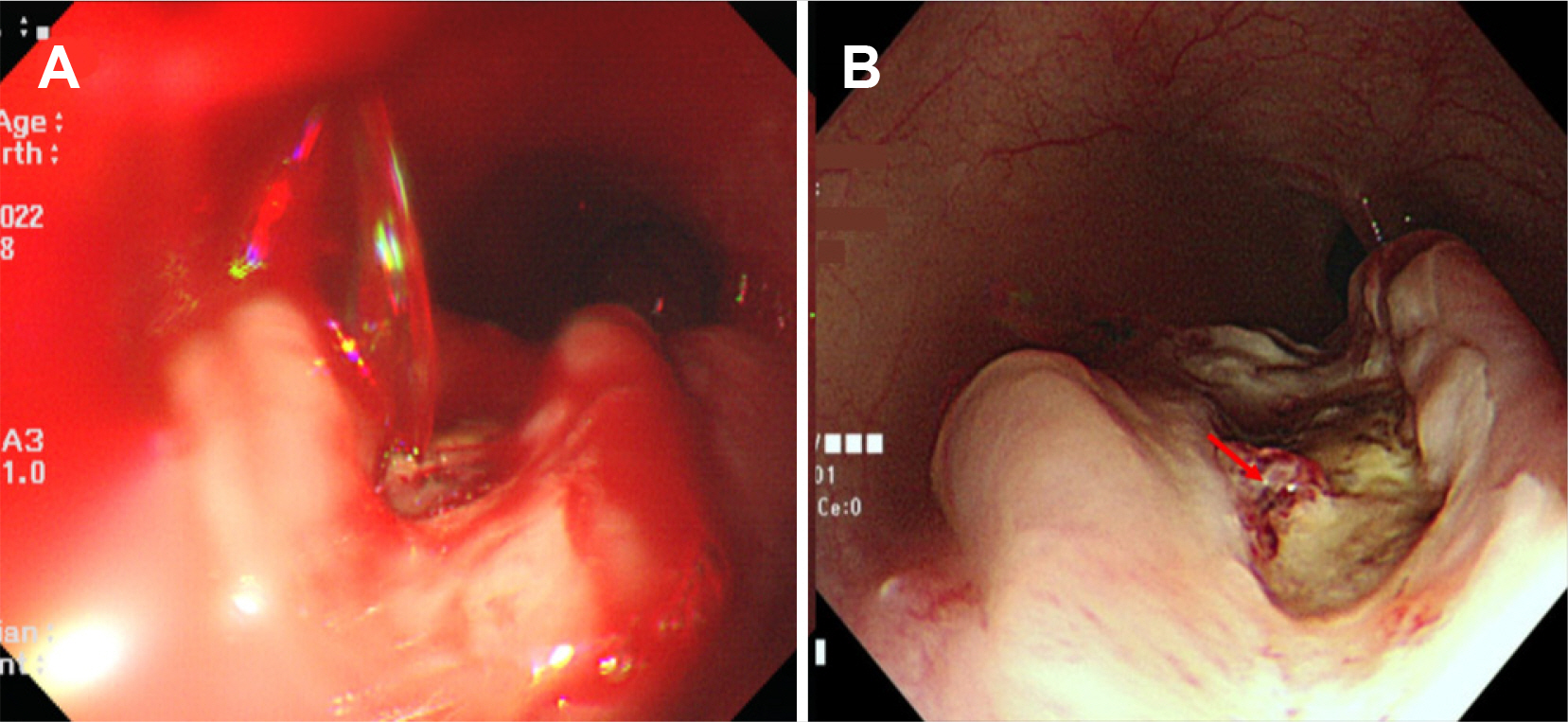Korean J Gastroenterol.
2022 Nov;80(5):229-232. 10.4166/kjg.2022.085.
Aortoesophageal Fistula Induced by an Indwelling Nasogastric Tube: A Case Report
- Affiliations
-
- 1Departments of Internal Medicine, Chungbuk National University Hospital, Chungbuk National University College of Medicine, Cheongju, Korea
- 2Departments of Radiology, Chungbuk National University Hospital, Chungbuk National University College of Medicine, Cheongju, Korea
- KMID: 2536352
- DOI: http://doi.org/10.4166/kjg.2022.085
Abstract
- A 91-year-old woman who presented with melena and hypovolemic shock visited the emergency room. She received enteral nutrition by nasogastric tube in a bedridden state due to hip surgery. Gastroscopy initially suggested a simple ulcer that occurred after a nasogastric tube was placed for a long time, but the ulcer was deep, and the amount of instantaneous bleeding was considerable. Therefore, an aortoesophageal fistula was suspected. Angiography was performed instead of endoscopic hemostasis, followed by thoracic endovascular aortic repair (TEVAR). After the TEVAR procedure, the patient recovered without further gastrointestinal bleeding. Prompt judgment and communication between the endoscopist and the interventional physician are important for successful hemostasis in an aortoenteric fistula patient.
Keyword
Figure
Reference
-
1. Stanley AJ, Laine L. 2019; Management of acute upper gastrointestinal bleeding. BMJ. 364:l536. DOI: 10.1136/bmj.l536. PMID: 30910853.
Article2. Motta APG, Rigobello MCG, Silveira RCCP, Gimenes FRE. 2021; Nasogastric/nasoenteric tube-related adverse events: an integrative review. Rev Lat Am Enfermagem. 29:e3400. DOI: 10.1590/1518-8345.3355.3400. PMID: 33439952. PMCID: PMC7798396.
Article3. Zhong XQ, Li GX. 2022; Successful management of life-threatening aortoesophageal fistula: a case report and review of the literature. World J Clin Cases. 10:3814–3821. DOI: 10.12998/wjcc.v10.i12.3814. PMID: 35647167. PMCID: PMC9100730.
Article4. Lee JY, Jang JS, Kim DK, Cha JH, Choi WJ. 2019; Endoscopic diagnosis of aortoesophageal fistula not presenting hematemesis. Korean J Gastroenterol. 73:35–38. DOI: 10.4166/kjg.2019.73.1.35. PMID: 30690956.
Article5. Kaushik S, Quencer K, Kraiss LW. 2021; Aortoesophageal fistula treated with emergent thoracic stent grafting. J Vasc Surg Cases Innov Tech. 7:396–398. DOI: 10.1016/j.jvscit.2021.04.001. PMID: 34278067. PMCID: PMC8261464.
Article6. Hollander JE, Quick G. 1991; Aortoesophageal fistula: a comprehensive review of the literature. Am J Med. 91:279–287. DOI: 10.1016/0002-9343(91)90129-L. PMID: 1892150.
Article7. Moon I, Jin KN, Kim HL, et al. 2019; Association of arterial stiffness with aortic calcification and tortuosity. Medicine (Baltimore). 98:e16802. DOI: 10.1097/MD.0000000000016802. PMID: 31415390. PMCID: PMC6831173.
Article8. Lewandrowski KB, Southern JF, Medeiros LJ, Jacobs M. 1989; Aortoesophageal fistula arising as a complication of prolonged nasogastric tube placement. Hum Pathol. 20:709–711. DOI: 10.1016/0046-8177(89)90161-5. PMID: 2786839.
Article9. Oe K, Araki T, Nakashima A, et al. 2009; Aortoesophageal fistula following nasogastric tube placement. Clin J Gastroenterol. 2:284–286. DOI: 10.1007/s12328-009-0095-7. PMID: 26192426.
Article10. Cohen-Gadol AA, White CB, Dekutoski MB, Shaughnessy WJ. 2003; Arterial-esophageal fistula: a complication of nasogastric tube placement after lumbar spine surgery: a case report. Spine (Phila Pa 1976). 28:E98–E101. DOI: 10.1097/01.BRS.0000048658.09306.BD. PMID: 12616174.11. Monteiro AS, Martins R, Martins da Cunha C, Moleiro J, Patrício H. 2020; Primary aortoesophageal fistula: is a high level of suspicion enough? Eur J Case Rep Intern Med. 7:001666.
- Full Text Links
- Actions
-
Cited
- CITED
-
- Close
- Share
- Similar articles
-
- Aortoesophageal Fistula and Sudden Death: A Report of a Case and Review of the Literature
- Primary Aortoesophageal Fistula: A case report
- A Nasogastric Tube Inserted into the Gastrocutaneous Fistula
- Repair of Tracheoesophageal Fistula under Laryngeal Microsurgery Approach: Case Report and Literature Review
- Self-Knotting of Nasogastric Tube in a Stroke Patient with Dysphagia: A Case Report





